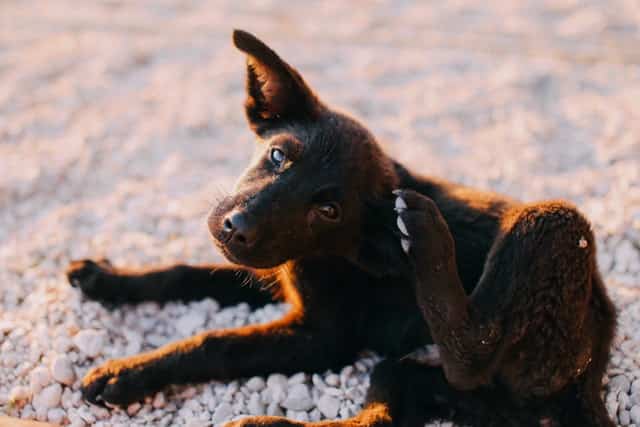
What do you think is the most common parasite that affects dogs? If you guessed fleas, you are correct! Fleas are tiny creatures that can cause a lot of problems for your dog. In this blog post, we will discuss how dogs get fleas, how to get rid of them, and what flea dirt is. We will also provide some tips on preventing your dog from getting fleas in the first place. Stay tuned!
Dogs can get fleas from a variety of sources. The most common way that dogs acquire fleas is by coming into contact with other animals that have them. This can happen when your dog plays with other dogs at the park, or even if you pet a dog that has fleas. Fleas can also jump from animal to animal, so even if your dog doesn’t have any fleas, he can still pick them up from other animals.
Once a flea jumps onto your dog, it will start to bite him and feed on his blood. This can cause your dog to feel itchy and uncomfortable. In severe cases, flea bites can lead to anemia in dogs. Fleas can also transmit other diseases to your dog, so it is important to get rid of them as soon as possible.
If you think your dog has fleas, the first thing you should do is check for flea dirt. Flea dirt is actually the feces of fleas, and it looks like small black dots on your dog’s skin. If you see flea dirt, it is a good indication that your dog has fleas.
If you suspect that your dog has fleas, there are a few things you can do to get rid of them. You can purchase a Flea comb and use it to remove the fleas from your dog’s fur. You can also give your dog a Flea bath, which will kill the fleas on contact. There are also many different kinds of Flea collars and sprays that you can use to prevent fleas from returning.
Preventing your dog from getting fleas in the first place is the best way to deal with the problem. There are a few things you can do to prevent fleas from jumping on your dog. First, make sure that you regularly groom your dog and remove any loose fur. You should also keep your dog’s environment clean and free of debris. Finally, you can purchase a Flea collar or spray that will help to repel fleas.

How to get rid of flea dirt on dogs
There are a few ways to get rid of flea dirt on dogs. The first is to vacuum regularly. This will help to remove any flea dirt that has been brought into the home. Secondly, bathe your dog regularly with a special shampoo or soap designed to kill fleas. Finally, make sure to keep your dog’s bedding clean and free of flea dirt. By following these simple steps, you can help to keep your dog flea-free!
How to get rid of fleas on newborn pup
There are a few things you can do to get rid of fleas on your newborn pup. The first thing you should do is take them to the vet. The vet can prescribe a medication that will kill the fleas and their eggs. You should also bathe your pup in a flea shampoo and use a flea comb to remove any fleas that are still on their fur. Finally, make sure to vacuum your house and wash all of your pup’s bedding to get rid of any fleas that may be in your home. By taking these steps, you can help keep your pup safe from fleas!
If you find that your pup still has fleas after taking these steps, you may need to consult with a professional. A professional can help you figure out what else you can do to get rid of the fleas and keep your pup safe. Remember, it’s important to take action right away if you suspect your pup has fleas. By taking these steps, you can help ensure that your pup stays healthy and flea-free!
How do dogs get fleas in the winter
There are a couple different ways that dogs can get fleas in the winter. One way is if they come into contact with another animal that has fleas. Another way is if they go outside and spend time in an area where there are fleas present. Fleas can also hitch a ride inside on your clothing or on other objects, and then jump onto your dog when they have the chance.
Preventing fleas is always the best option, but if your dog does end up with fleas, there are a few things you can do to get rid of them. You can bathe your dog with a flea shampoo, and you can also use a flea comb to remove the fleas from their fur. You may also need to treat your home for fleas if they are present. If you have any questions or concerns about fleas, be sure to talk to your veterinarian. They will be able to give you the best advice for your individual situation.
How to get dog to eat flea pill
If your dog is resistant to taking their flea pill, there are a few things you can do to make the process easier. First, try hiding the pill in a piece of cheese or peanut butter. If your dog is still resistant, you may need to open their mouth and place the pill as far back on their tongue as possible.
Once the pill is in their mouth, close their mouth and rub their throat until they swallow. If your dog is still not cooperative, you may need to consult with your veterinarian for additional tips.
Once you have successfully administered the flea pill, be sure to give your dog plenty of praise and treats. This will help them to associate taking their flea pill with something positive. With a little patience and persistence, you will be able to get your dog to take their flea pill with no problem.

What are fleas?
Fleas are small, wingless insects that measure just two to eight millimeters in length. These agile pests are powerful jumpers, able to leap vertically up to seven inches and horizontally up to thirteen inches. In fact, their jumping ability is so impressive that it’s been estimated that a flea could theoretically jump the height of a three-story building, given enough time to make the leap.
Fleas are parasites that feed on the blood of animals, including dogs and humans. A single flea can consume up to 15 times its own body weight in blood every day. Fleas can also transmit diseases from one host to another, which is why it’s so important to keep them under control.
There are many different products available to help control fleas. Some of these products are applied directly to the skin of the animal, while others are ingested. Flea pills are an oral medication that is given to dogs in order to kill fleas and prevent infestations.
Flea pills typically contain insecticidal chemicals that work by either killing fleas outright or by preventing them from reproducing. Some of the most common insecticides used in flea pills include pyrethroids, organophosphates, and carbamates.
When used as directed, flea pills are safe and effective at killing fleas and preventing infestations. However, some dogs may be resistant to taking their flea pill. If this is the case, there are a few things you can do to make the process easier.
First, try hiding the pill in a piece of cheese or peanut butter. If your dog is still resistant, you may need to open their mouth and place the pill as far back on their tongue as possible.
Once the pill is in their mouth, close their mouth and rub their throat until they swallow. If your dog is still not cooperative, you may need to consult with your veterinarian for additional tips.
Once you have successfully administered the flea pill, be sure to give your dog plenty of praise and treats. This will help them to associate taking their flea pill with something positive. With a little patience and persistence, you will be able to get your dog to take their flea pill with no problem.
What are the side effects of flea pills?
The most common side effect of flea pills is gastrointestinal upset, which can include vomiting, diarrhea, and loss of appetite. In some cases, flea pills can also cause seizures. If you notice any of these side effects in your dog after giving them a flea pill, be sure to contact your veterinarian right away.
How do I know if my dog has fleas?
There are a few telltale signs that your dog may have fleas. If you notice your dog scratching or biting at their skin more than usual, this could be a sign that they’re trying to relieve themselves of itchiness caused by fleas. You may also notice small black dots on your dog’s fur; these are flea droppings, and are another indication that your dog has fleas. Finally, if you part your dog’s fur and look closely, you may be able to see small, dark-colored insects crawling around; these are the fleas themselves. If you notice any of these signs, it’s time to take action to get rid of the fleas.
